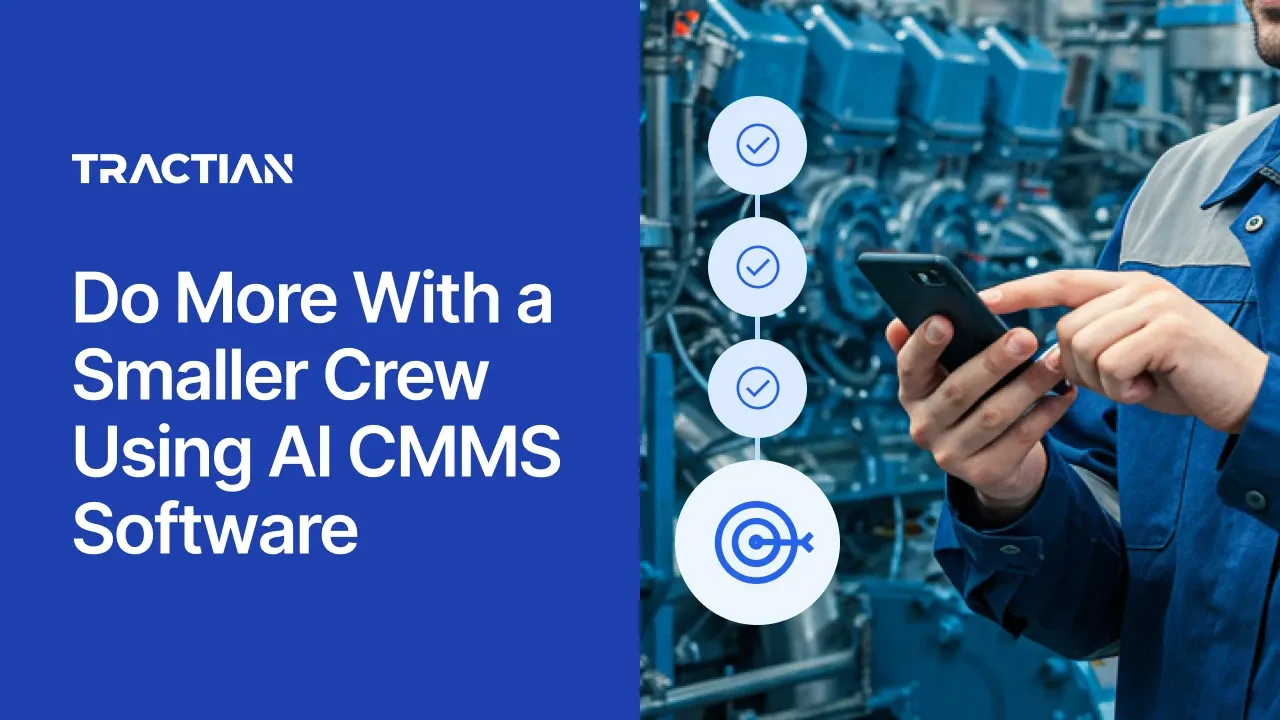Across manufacturing and heavy industry, maintenance leaders face a shared reality: smaller crews, rising demands, and no room for inefficiency. Where ten technicians once handled daily operations, now five must keep critical assets online. This is no longer a temporary labor challenge. It is the new normal.
Running maintenance with a small crew means every decision carries more weight. Every technician must cover more ground. Every misstep directly threatens production. It means that understaffed maintenance solutions are no longer optional but essential. Yet, within this pressure-filled environment lies a remarkable opportunity. With the arrival of AI-powered CMMS platforms, lean maintenance teams can now operate with the intelligence, precision, and productivity once reserved for larger crews.
Artificial intelligence is no longer a futuristic add-on. In maintenance, it is becoming the foundation. By embedding AI into workflows, guiding technicians with automated SOPs, and analyzing documents at speeds no human team could match, AI CMMS systems give lean maintenance teams the ability to perform as if they were fully staffed.
Why the Maintenance Labor Shortage Isn’t Going Away
The maintenance labor shortage is not a distant forecast. It is already here. Data from The Bureau of Labor Statistics highlights a significant employment drop in the industrial sector since the early 2000s.

In addition, recent studies indicate that the industrial sector is struggling to replace a retiring workforce, while demand for technical expertise continues to climb. Deloitte projects that millions of manufacturing jobs will remain unfilled over the next decade, creating not only a talent gap but also a widening skills gap. At the same time, organizations are under pressure to increase productivity, reduce costs, and keep assets running longer.
For the maintenance manager, this means doing more with fewer technicians. A lean maintenance team is no longer a temporary condition. It is a structural shift in the industry. Unfortunately, most companies continue to rely on traditional methods to address the problem. They invest in apprenticeships, launch upskilling programs, and attempt to stretch every hour of labor. While these initiatives are valuable, they take time to pay off and cannot scale at the pace that modern operations demand.
The result is a paradox. Crews are smaller, assets are more complex, and expectations are higher. Without the right tools, lean teams fall into a reactive cycle where emergency repairs, overtime, and burnout become the norm. Breaking this cycle requires a new approach, one that builds efficiency into every action a technician takes.
Why Training and Upskilling Alone Fall Short
For decades, apprenticeships and training programs were considered the gold standard for solving labor shortages. A senior technician could pass knowledge to a new generation while companies invested in programs that blended classroom instruction with hands-on experience. Upskilling also became common, giving existing workers the chance to adapt to new equipment and technologies.
Although these approaches remain valuable, they are no longer sufficient. Training a technician can take years, yet the pace of industrial change demands immediate results. Machines are more connected and more data-driven, while relying on manual inspections or outdated workflows leaves lean teams constantly behind. Traditional solutions simply cannot deliver the speed, scalability, or insight required to keep understaffed crews effective.
This is where digital transformation changes the equation. By moving from labor-heavy processes to AI-powered automation, organizations no longer rely exclusively on workforce expansion. Instead, they use technology to extend the reach of every technician, multiplying the impact of lean maintenance teams without sacrificing quality or reliability.
How AI Unlocks Scalable Execution for Small Crews
AI-powered CMMS platforms now represent the most effective understaffed maintenance solution. Instead of asking small crews to work harder, they enable teams to work smarter.
One of the most significant advancements is AI SOPs. Standard operating procedures have always been the backbone of maintenance, but they were often static, buried in binders, or scattered across disconnected systems. With AI SOPs, procedures are dynamic and contextual. The CMMS interprets the condition of the asset and generates step-by-step instructions tailored to the task. Technicians no longer waste time searching through manuals or double-checking compliance requirements. Instructions are delivered in real time, ensuring tasks are completed safely, consistently, and efficiently.
Another critical breakthrough is Document Analysis. Maintenance operations generate enormous volumes of information, from manuals and inspection checklists to compliance records and historical logs. Searching through these documents is a hidden drain on productivity. AI-powered Document Analysis eliminates this inefficiency by instantly scanning, interpreting, and extracting relevant information. A technician can ask the system how to recalibrate a pump or verify compliance requirements, and the AI will surface the precise answer within seconds.
Together, AI SOPs and Document Analysis create a multiplier effect. Crews are no longer limited by size. They are supported by intelligent tools that manage the information load, allowing technicians to focus on execution and results.
How Lean Teams Achieve Efficiency Through AI
The value of AI is most visible in the daily operations of lean crews. Imagine a team of four technicians responsible for hundreds of assets in a single facility. Without AI, their shift is consumed by manual logging, document searches, reactive repairs, and working long hours to keep up.
With AI CMMS, their day looks very different. Sensors continuously monitor equipment, predicting failures before they occur. When a potential issue is detected, the CMMS generates a work order automatically, assigns it to the appropriate technician, and attaches an AI SOP with the exact steps required. If the technician needs clarification on torque levels or safety measures, they can ask the system directly, which uses Document Analysis to deliver the answer instantly.
Instead of reacting under pressure, the crew works in a calm, coordinated manner. Instead of guessing, they are guided by data and AI-driven instructions. Instead of wasting time on administrative tasks, they spend their hours on value-added work.
The ROI of Lean Maintenance Team Efficiency
For companies facing workforce pressure, the return on AI CMMS adoption is clear. Predictive maintenance reduces unplanned downtime, allowing operations to run smoothly with fewer disruptions. AI SOPs shorten task execution times and reduce errors, which eliminates costly rework. Document Analysis ensures technicians never lose time searching for information, improving responsiveness and accuracy.
According to PwC, AI-enabled predictive maintenance can lower maintenance costs by up to 30% and cut unplanned downtime by as much as 45%. For lean maintenance crews, these improvements aren’t just efficiencies, they’re game-changers. You may not be able to double your staff, but with AI CMMS, you can effectively double your team’s efficiency.
How Tractian Helps Small Crews Operate Like Large Ones
Tractian has designed its AI CMMS to meet the challenges of lean maintenance environments at scale. AI SOPs ensure that every technician, regardless of experience, can execute tasks with confidence and precision. By embedding intelligence into workflows, the platform accelerates task execution while minimizing human error that could lead to costly downtime.
Through advanced Document Analysis, Tractian eliminates one of the greatest inefficiencies for lean crews: the time wasted searching for information. Whether it is a compliance requirement, a technical specification, or historical asset data, the CMMS surfaces the right information instantly. This enables consistency across shifts, ensures regulatory alignment, and gives crews immediate access to the knowledge they need.
These capabilities do not replace people. They empower them. For maintenance with a small crew, Tractian CMMS is not simply a digital platform. It is a strategic force multiplier that allows organizations to protect uptime and efficiency in even the most resource-constrained environments.
Real-World Results With AI CMMS
The impact of these technologies is already visible across industries. Organizations that adopt AI SOPs and Document Analysis are seeing measurable gains in efficiency, reliability, and uptime.
Ingredion, a global food ingredients manufacturer, Tractian’s AI CMMS delivered predictive insights that helped teams anticipate failures before they occurred. By reducing unplanned downtime, Ingredion was able to protect production and improve overall asset reliability without adding strain to its workforce.
CP Kelco, a leader in nature-based ingredients, turned to Tractian to streamline its complex documentation needs. With AI Document Analysis, technicians gained instant access to equipment manuals and compliance records that once slowed them down. Repair times were cut significantly and compliance tasks became faster and more consistent.
These examples demonstrate that whether supporting enterprise-scale operations or lean maintenance environments, Tractian’s AI CMMS gives teams the tools to achieve more. By combining predictive insights with AI SOPs and Document Analysis, companies are protecting uptime, reducing inefficiencies, and enabling crews to work at their highest level of performance.
Smarter Maintenance Is the Future and It’s Here
As industries adapt to shrinking workforces and rising production demands, one truth is clear. Maintenance with small crews is not a temporary challenge but a long-term reality. Success will not come from simply adding headcount. It will come from working smarter and embedding intelligence into every aspect of operations.
AI SOPs and Document Analysis are redefining what maintenance teams can achieve. They ensure that every task is executed with accuracy, every answer is delivered instantly, and every technician’s time is directed to the work that matters most. With the support of AI, organizations are transforming lean maintenance environments into efficient, resilient, and competitive operations that can thrive even under workforce constraints.
Doing More With Less, The Smart Way
The shift toward smarter operations is already underway, and Tractian is leading the way. Tractian CMMS is designed to help organizations move beyond traditional limitations by embedding AI into every stage of maintenance.
With AI SOPs that deliver clear execution guidance and Document Analysis that unlocks instant answers from even the most complex technical libraries, Tractian equips teams to achieve world-class reliability and efficiency. These are not abstract promises but practical capabilities already delivering results for global enterprises.
The question is no longer whether lean maintenance can succeed. The question is how quickly you will empower your team with the tools that make smarter operations possible.
Are you ready to see how Tractian CMMS can transform your maintenance strategy? Request a demo today.
FAQ: Smarter Maintenance With AI CMMS
What does it mean to preserve maintenance tribal knowledge?
Preserving maintenance tribal knowledge means capturing the on-the-job experience, best practices, and intuitive problem-solving skills developed by seasoned technicians. This type of knowledge is rarely written down but is critical for efficient troubleshooting and long-term asset reliability. Learn how Tractian helps preserve it.
What types of industries benefit most from this kind of AI-powered support?
Sectors that rely on continuous uptime and face strict regulatory or production requirements benefit the most. These include food and beverage, automotive, mining, chemical processing, and agriculture. In these environments, a single failure or delay can translate to high financial or safety risks.
How does Tractian’s CMMS stand apart from other platforms?
Tractian’s CMMS is more than just a place to track work orders. It helps teams execute with greater intelligence and speed. Technicians receive SOP guidance that adapts to real-time asset conditions, access the exact documentation they need in seconds, and rely on continuous equipment monitoring to stop failures before they start. All of this happens within a single platform built for scale, efficiency, and frontline performance.


